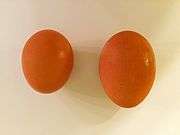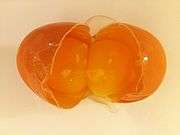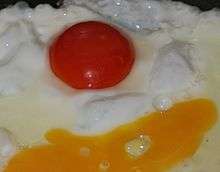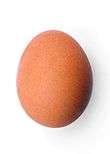Yolk

The yolk in an egg is material of which the primary function is to supply food for the development of the animal embryo. Some kinds of eggs contain no yolk, for example because they are laid in situations where the food supply is adequate (such as in the body of the host of a parasitoid) or because the embryo develops in the parent's body, which supplies the food, sometimes through a placenta. Reproductive systems in which the mother's body supplies the embryo directly are said to be matrotrophic; those in which the embryo is supplied by yolk are said to be lecithotrophic. In many species, such as all birds, and most reptiles and insects, the yolk takes the form of a special storage organ constructed in the reproductive tract of the mother. In many other animals, especially very small species such as some fishes and invertebrates, the yolk material is not in a special organ,but inside the ovum.
Yolks, being mainly stored food, tend to be very concentrated, and in particular tend to be rich in nutrients such as vitamins, minerals, lipids and proteins. The proteins function partly as food in their own right, and partly in controlling the storage and supply of the other nutrients. For example, in some species the amount of yolk in an egg cell affects the developmental processes that follow fertilization. Yolk is not living cell material like protoplasm, but largely passive material, that is to say deutoplasm, in this case functioning mainly as food for the embryo. The food material, plus associated control structures, is supplied by the maternal body during the process called oogenesis. Some of the material is stored more or less in the form in which the maternal body supplied it, partly as processed by dedicated non-germ tissues in the egg, while part of the biosynthetic processing into its final form happens in the oocyte itself.[1]
Apart from animals, other organisms, like algae, specially in the oogamous, can also accumulate resources in their female gametes. In gymnosperms, the remains of the female gametophyte serve also as food supply, and in flowering plants, the endosperm.
Chicken egg yolk
In the avian egg, the yolk usually is some shade of yellow in colour. It is spherical and is suspended in the egg white (known alternatively as albumen or glair/glaire) by one or two spiral bands of tissue called the chalazae. Prior to fertilization, the yolk is a single cell, the ovum or egg cell, one of the few single cells that can be seen by the naked eye.[2] This fact was discovered by Hoyer in 1858.[3]
After the fertilization, the cleavage leads to the formation of the germinal disc.
As food, the chicken egg yolk is a major source of vitamins and minerals. It contains all of the egg's fat and cholesterol, and nearly half of the protein. If left intact when an egg is fried, the yellow yolk surrounded by a flat blob of egg white creates a distinctive "sunny-side up" form. Mixing the two components together before frying results in a pale yellow mass, as in omelettes and scrambled eggs.
Uses
- The developing embryo inside the egg uses the yolk as sustenance.
- It is at times separated from the egg white and used in cooking (for mayonnaise, custard, hollandaise sauce, crème brûlée, avgolemono, and ovos moles).
- It is used in painting as a component of traditional egg-tempera.
- It is used in the production of egg-yolk agar plate medium, useful in testing for the presence of Clostridium perfringens.
- Egg yolk contains an antibody called antiglobulin (IgY). The antibody transfers from the laying hen to the egg yolk by passive immunity to protect both embryo and hatchling from microorganism invasion.
- Egg yolk can be used to make liqueurs such as Advocaat or eggnog.
- Egg yolk is used to extract egg oil which has various cosmetic, nutritional and medicinal uses.
Composition of chicken egg yolk
| Nutritional value per 100 g (3.5 oz) | |
|---|---|
| Energy | 1,325 kJ (317 kcal) |
|
3.59 g | |
|
26.54 g | |
|
15.86 g | |
| Tryptophan | 0.177 g |
| Threonine | 0.687 g |
| Isoleucine | 0.866 g |
| Leucine | 1.399 g |
| Lysine | 1.217 g |
| Methionine | 0.378 g |
| Cystine | 0.264 g |
| Phenylalanine | 0.681 g |
| Tyrosine | 0.678 g |
| Valine | 0.949 g |
| Arginine | 1.099 g |
| Histidine | 0.416 g |
| Alanine | 0.836 g |
| Aspartic acid | 1.550 g |
| Glutamic acid | 0.595 g |
| Glycine | 0.488 g |
| Proline | 0.545 g |
| Serine | 1.326 g |
| Vitamins | |
| Vitamin A equiv. |
(48%) 381 μg |
| Thiamine (B1) |
(15%) 0.176 mg |
| Riboflavin (B2) |
(44%) 0.528 mg |
| Pantothenic acid (B5) |
(60%) 2.990 mg |
| Folate (B9) |
(37%) 146 μg |
| Choline |
(167%) 820.2 mg |
| Vitamin D |
(36%) 218 IU |
| Minerals | |
| Calcium |
(13%) 129 mg |
| Iron |
(21%) 2.73 mg |
| Magnesium |
(1%) 5 mg |
| Phosphorus |
(56%) 390 mg |
| Potassium |
(2%) 109 mg |
| Zinc |
(24%) 2.30 mg |
| Other constituents | |
| Water | 52.31 g |
| Cholesterol | 1085 mg |
|
One large egg contains 17 grams of yolk. | |
| |
|
Percentages are roughly approximated using US recommendations for adults. Source: USDA Nutrient Database | |
The yolk makes up about 33% of the liquid weight of the egg; it contains approximately 60 calories, three times the caloric content of the egg white.
The yolk of one large egg (50 g total, 17 g yolk) contains approximately: 2.7 g protein, 210 mg cholesterol, 0.61 g carbohydrates, and 4.51 g total fat.[4]
All of the fat-soluble vitamins (A, D, E, and K) are found in the egg yolk. Egg yolk is one of the few foods naturally containing vitamin D.
The composition (by weight) of the most prevalent fatty acids in egg yolk is typically as follows:[5]
- Unsaturated fatty acids:
- Oleic acid, 47%
- Linoleic acid, 16%
- Palmitoleic acid, 5%
- Linolenic acid, 2%
- Saturated fatty acids:
- Palmitic acid, 23%
- Stearic acid, 4%
- Myristic acid, 1%
Egg yolk is a source of lecithin as well as egg oil for cosmetic and pharmaceutical applications. Based on weight, egg yolk contains about 9% lecithin.[6]
The yellow color is due to lutein and zeaxanthin, which are yellow or orange carotenoids known as xanthophylls.
Yolk proteins
The different yolk's protein has distinct roles. Phosvitins are important in sequestering calcium, iron and other cations for the developing embryo. Phosvitins are one of the most phosphorylated (10%) proteins in nature, the high concentration of phosphate groups providing efficient metal-binding sites in clusters.[7][8] Lipovitellins are involved in lipid and metal storage, and contain a heterogeneous mixture of about 16% (w/w) noncovalently bound lipid, most being phospholipid. Lipovitellin-1 contains two chains, LV1N and LV1C.[9][10]
Yolk vitamins and minerals
Yolks hold more than 90% of the calcium, iron, phosphorus, zinc, thiamine, vitamin B6, folate, vitamin B12 and pantothenic acid of the egg. In addition, yolks cover all of the fat soluble vitamins A, D, E and K in the egg, as well as all of the essential fatty acids (EFAs).
A single yolk from a large egg contains approximately 22 mg of calcium, 66 mg of phosphorus, 9.5 micrograms of selenium and 19 mg of potassium, according to the USDA. Refer to the chart at right for quantities of nutrients per 100g of egg yolk.[11]
Double-yolk eggs
Double-yolk eggs occur when ovulation occurs too rapidly, or when one yolk becomes joined with another yolk. These eggs may be the result of a young hen's reproductive cycle not yet being synchronized.[12]
Double-yolked eggs seldom lead to successful hatchlings without human intervention, as the chicks interfere with each other's hatching process and do not survive.[13]
Higher-order yolks are rare, although heavier poultry breeds such as the Buff Orpington have been known to lay triple-yolk eggs occasionally.

Comparison of an egg and a maxi egg with a double-yolk (closed) 
Comparison of an egg and a maxi egg with a double-yolk (opened) 
Double-yolk egg - Opened
Yolkless eggs
Eggs without yolks are known as "dwarf" or "wind" eggs,[14] or the archaic term "cock egg".[15] Such an egg is most often a pullet's first effort, produced before her laying mechanism is fully ready. Mature hens rarely lay a yolkless egg, but it sometimes happens that a piece of reproductive tissue breaks away and passes down the tube. Such a scrap of tissue may stimulate the egg-producing glands to react as though it were a yolk and wrap it in albumen, membranes and a shell as it travels through the egg tube. This is usually what causes an egg to contain a small particle of grayish tissue instead of a yolk.
Since these eggs contain no yolk and therefore can not hatch, they were traditionally believed to have been laid by roosters.[16] This type of egg occurs in many varieties of fowl and has been found in chickens, both standard and bantams, guineas and coturnix quail.
Yolk color

The color of an egg yolk is directly influenced by the makeup of the chicken feed.[17] Egg yolk color is generally improved with a feed containing a large component of yellow, fat-soluble pigments, such as the carotenes in dark green plant material, for example alfalfa. Although much emphasis is put onto the color of the egg yolk, it does not reliably reflect the nutritional value of an egg. For example, some of the natural pigments that produce a rich yolk color are xanthophylls without much nutritional value, rather than the carotenoids that act as provitamin A in the body. Also, a diet rich in vitamin A itself, but without A-provitamins or xanthophylls, can produce practically colourless yolks that are just as nutritious as any richly colored yolks. Since unhealthy chickens produce fewer and smaller eggs, farmers ensure that whatever the source of their feed, the quality is adequate, so there is not likely to be much difference in the nutritional quality of the eggs.[18]
Yolks, particularly from free-range eggs, can be of a wide range of colors, ranging from nearly white, through yellow and orange to practically red, or even olive green, depending on the pigments in their food. Feeding fowls large amounts of capsicum peppers for example, tends to result in red or deep orange yolks. This has nothing to do with adding colors such as cochineal to eggs in cooking.[19]
In fish
All bony fish, some sharks and rays have yolk sacs at some stage of development, with all oviparous fishes retaining the sac after hatching. Lamniform sharks are ovoviviparous, in that their eggs hatch in utero, in addition to eating unfertilized eggs, unborn sharks participate in intrauterine-cannibalism: stronger sharklets consume their weaker womb-mates.[20][21][22]
References
- ↑ Barnes, Richard Stephen Kent (2001). The Invertebrates: A Synthesis. Wiley-Blackwell, p. 347. ISBN 978-0-632-04761-1.
- ↑ Patten, B. M. (1951). Early Embryology of the Chick, 4th edition. McGraw-Hill, New York, p. 17.
- ↑ Callebaut, M. (2008) Historical evolution of preformistic versus neoformistic (epigenetic) thinking in embryology, Belgian Journal of Zoology, vol. 138 (1), pp. 20–35, 2008
- ↑ U.S. Department of Agriculture, Agricultural Research Service, 2010. USDA National Nutrient Database for Standard Reference, Release 23, Nutrient Data Laboratory Home Page: http://www.ars.usda.gov/nutrientdata
- ↑ National Research Council, 1976, Fat Content and Composition of Animal Products, Printing and Publishing Office, National Academy of Science, Washington, D.C., ISBN 0-309-02440-4; p. 203, online edition
- ↑ Chris Clarke (2004). The science of ice cream. Cambridge, Eng: Royal Society of Chemistry. p. 49. ISBN 0-85404-629-1. Retrieved 2013-03-20.
Egg yolk has the approximate composition (by weight) of 50% water, 16% protein, 9% lecithin, 23% other fat, 0.3% carbohydrate and 1.7% minerals.
- ↑ Matsubara T, Sawaguchi S, Ohkubo N (2006). "Identification of two forms of vitellogenin-derived phosvitin and elucidation of their fate and roles during oocyte maturation in the barfin flounder, Verasper moseri". Zool. Sci. 23 (11): 1021–9. doi:10.2108/zsj.23.1021. PMID 17189915.
- ↑ Goulas A, Triplett EL, Taborsky G (1996). "Oligophosphopeptides of varied structural complexity derived from the egg phosphoprotein, phosvitin". J. Protein Chem. 15 (1): 1–9. doi:10.1007/BF01886805. PMID 8838584.
- ↑ Banaszak LJ, Thompson JR (2002). "Lipid-protein interactions in lipovitellin". Biochemistry. 41 (30): 9398–9409. doi:10.1021/bi025674w. PMID 12135361.
- ↑ Banaszak LJ, Anderson TA, Levitt DG (1998). "The structural basis of lipid interactions in lipovitellin, a soluble lipoprotein". Structure. 6 (7): 895–909. doi:10.1016/S0969-2126(98)00091-4. PMID 9687371.
- ↑ U.S. Department of Agriculture, Agricultural Research Service, 2010. USDA National Nutrient Database for Standard Reference, Release 23, Nutrient Data Laboratory Home Page: http://www.ars.usda.gov/nutrientdata
- ↑ "Odd Eggs, Double Yolks, No Yolks, etc.". poultryhelp.com. 2005-03-04. Retrieved 2008-10-25.
- ↑ Kruszelnicki, Karl S. (2003). "Double-yolked eggs and chicken development". Australian Broadcasting Corporation. Retrieved 2007-12-09.
- ↑ "Dwarf Eggs and the Timing of Ovulation in the Domestic Fowl". Nature Publishing Group. 1996-06-25. Retrieved 2008-10-25.
- ↑ "Cock's egg". Retrieved 2010-09-02.
- ↑ http://www.oedilf.com/db/Lim.php?Word=cock%27s%20egg
- ↑ Poultry Science by richard page 216
- ↑ Donald D. Bell; William Daniel Weaver (January 2002). Commercial Chicken Meat and Egg Production. Springer. ISBN 978-0-7923-7200-4. Retrieved 1 September 2013.
- ↑ Mathew Attokaran (13 January 2011). Natural Food Flavors and Colorants. John Wiley & Sons. pp. 1–. ISBN 978-0-470-95911-4. Retrieved 1 September 2013.
- ↑ Meisner, A & Burns, J: Viviparity in the Halfbeak Genera Dermogenys and Nomorhamphus (Teleostei: Hemiramphidae). Journal of Morphology 234, pp. 295–317, 1997
- ↑ Peter Scott: Livebearing Fishes, p. 13. Tetra Press 1997. ISBN 1-56465-193-2
- ↑ Leonard J. V. Compagno (1984). Sharks of the World: An annotated and illustrated catalogue of shark species known to date. Food and Agriculture Organization of the United Nations. ISBN 92-5-104543-7. OCLC 156157504.
External links
| Wikibooks Cookbook has a recipe/module on |
| Look up yolk in Wiktionary, the free dictionary. |
- Anatomy of an Egg from the Exploratorium
- Making egg tempera from the Society of Tempera Painters
